An Automatic Generation Method of Finite Element Model Based on BIM and Ontology
Abstract
:1. Introduction
2. Information Analysis of Finite Element Model
3. Information Extraction and Reasoning Method
3.1. Information Extraction Based on OpenBIM and Intelligent Reasoning Based on Ontology
3.2. Analysis of IFC Standard
3.2.1. Express-G Model of Component Property and Quantity Information Extraction
3.2.2. Material Information Expression Based on IFC
3.2.3. Information Extraction of Spatial Model Based on IFC
3.3. Automatic Decision Making of Element Type Based on BIM and Ontology
3.4. Geometric Modeling and Command Stream Generation
- KATT commands are obtained according to the characteristics of the node.
- Material values are obtained according to the model material of the node, and the corresponding material number of the component is obtained from the definition statement of the material.
- The real constant number, the element type number, and the coordinate system number are obtained in similar ways.
- One to three are filled into the corresponding position by programming statements.
3.5. Case Study
4. BIM-FEM Conversion Process and Software Architecture Design
5. Conclusions
Author Contributions
Funding
Data Availability Statement
Conflicts of Interest
References
- Azhar, S. Building Information Modeling (BIM): Trends, Benefits, Risks, and Challenges for the AEC Industry. Leadersh. Manag. Eng. 2011, 11, 241–252. [Google Scholar] [CrossRef]
- Lai, H.H.; Deng, X.Y. Interoperability Analysis of Ifc-Based Data Exchange between Heterogeneous Bim Software. J. Civ. Eng. Manag. 2018, 24, 537–555. [Google Scholar] [CrossRef]
- ANSYS. Available online: https://www.ansys.com (accessed on 22 October 2022).
- Abaqus. Available online: https://www.3ds.com/products-services/simulia/products/abaqus/ (accessed on 22 October 2022).
- Adina. Available online: https://www.adina.com/ (accessed on 22 October 2022).
- Klinc, R.; Gabršček, D.; Česnik, J.; Žibert, M.; Hostnik, M.; Logar, J. Development of a Semiautomatic Parametric Method for Creation of an I-BIM Model of a Tunnel for Use in FEM Software. J. Adv. Transp. 2021, 2021, 8843277. [Google Scholar] [CrossRef]
- Volk, R.; Stengel, J.; Schultmann, F. Building Information Modeling (BIM) for Existing Buildings-Literature Review and Future Needs. Autom. Constr. 2014, 38, 109–127. [Google Scholar] [CrossRef] [Green Version]
- Xiao, L.; Liu, Y.; Du, Z.; Yang, Z.; Xu, K. Model Analysis and Optimization of Bim Technology in High-Rise Shear Wall Residential Structure. MATEC Web Conf. 2019, 3, 1–5. [Google Scholar] [CrossRef]
- Zhou, H.; He, X.; Leng, X.L. Development and Application of a Revit-ANSYS Model Transformation Interface. In IOP Conference Series: Earth and Environmental Science, Proceedings of the 11th Conference of Asian Rock Mechanics Society, Beijing, China, 21–25 October 2021; IOPscience: Bristol, UK, 2021; Volume 861, pp. 1–8. [Google Scholar]
- Jeong, Y.-S.; Eastman, C.; Sacks, R.; Kaner, I. Benchmark Tests for Bim Data Exchanges of Precast Concrete. Automat. Constr. 2009, 18, 469–484. [Google Scholar] [CrossRef]
- Habte, B.; Guyo, E. Application of Bim for Structural Engineering: A Case Study Using Revit and Customary Structural Analysis and Design Software. J. Inf. Technol. Constr. 2021, 26, 1009–1022. [Google Scholar] [CrossRef]
- Liu, Z.Q.; Li, Y.G.; Zhang, H.Y. Ifc-Based Integration Tool for Supporting Information Exchange from Architectural Model to Structural Model. J. Central South Univ. Technol. 2010, 17, 1344–1350. [Google Scholar] [CrossRef]
- Xu, Z.; Rao, Z.; Gan, V.J.L.; Ding, Y.; Wan, C.; Liu, X. Developing an Extended Ifc Data Schema and Mesh Generation Framework for Finite Element Modeling. Adv. Civ. Eng. Mater. 2019, 2019, 1434093. [Google Scholar] [CrossRef]
- Park, S.I.; Lee, S.-H.; Almasi, A.; Song, J.-H. Extended Ifc-Based Strong Form Meshfree Collocation Analysis of a Bridge Structure. Autom. Constr. 2020, 119, 1–21. [Google Scholar] [CrossRef]
- Zou, D.; Chen, K.; Kong, X.; Yu, X. An Approach Integrating Bim, Octree and Fem-Sbfem for Highly Efficient Modeling and Seismic Damage Analysis of Building Structures. Eng. Anal. Bound. Elem. 2019, 104, 332–346. [Google Scholar] [CrossRef]
- Alsahly, D.A.; Hegemann, D.F.; König, D.M.; Meschke, T.G. Integrated Bim-to-Fem Approach in Mechanised Tunnelling. Geomech. Tunn. 2020, 13, 212–220. [Google Scholar] [CrossRef]
- Khan, M. Integrating BIM with ERP Systems Towards an Integrated Multiuser Interactive Database: Reverse-BIM Approach. In Recent Trends in Construction Technology and Management. Lecture Notes in Civil Engineering; Ranadive, M.S., Das, B.B., Mehta, Y.A., Gupta, R., Eds.; Springer: Singapore, 2022; Volume 260, pp. 209–220. ISBN 978-981-19-2145-2_17. [Google Scholar]
- Swanson, J.A.; Cameron, G.R.; Haberland, J.C. Adapting the Ansys Finite-Element Analysis Program to an Attached Processor. Computer 1983, 16, 85–91. [Google Scholar] [CrossRef]
- IFC4 Documentation. Available online: https://standards.buildingsmart.org/IFC/RELEASE/IFC4/ADD2_TC1/HTML/ (accessed on 22 October 2022).
- Oneline Documatation for the Revit API. Available online: https://www.revitapidocs.com/ (accessed on 22 October 2022).
- Venugopal, M.; Eastman, C.M.; Sacks, R.; Teizer, J. Semantics of Model Views for Information Exchanges Using the Industry Foundation Class Schema. Adv. Eng. Inform. 2012, 26, 411–428. [Google Scholar] [CrossRef]
- Jiang, S.; Jiang, L.; Han, Y.; Wu, Z.; Wang, N. OpenBIM: An Enabling Solution for Information Interoperability. Appl. Sci. 2019, 9, 5358. [Google Scholar] [CrossRef] [Green Version]
- buildingSMART. Available online: https://technical.buildingsmart.org/ (accessed on 22 October 2022).
- Sinha, P.K.; Gajbe, S.B.; Debnath, S.; Sahoo, S.; Chakraborty, K.; Mahato, S.S. A Review of Data Mining Ontologies. Data Technol. Appl. 2021, 56, 172–204. [Google Scholar] [CrossRef]
- Studer, R.; Benjamins, V.R.; Fensel, D. Knowledge Engineering: Principles and Methods. Data Knowl. Eng. 1998, 25, 161–197. [Google Scholar] [CrossRef] [Green Version]
- Rasmussen, M.H.; Lefrançois, M.; Schneider, G.F.; Pauwels, P. Bot: The Building Topology Ontology of the W3c Linked Building Data Group. Semant. Web 2021, 12, 143–161. [Google Scholar] [CrossRef]
- Mohammadi, S.; Tavakolan, M.; Zahraie, B. An Intelligent Simulation-Based Framework for Automated Planning of Concrete Construction Works. Eng. Constr. Arch. Manag. 2022, 29, 916–939. [Google Scholar] [CrossRef]
- Gennari, J.H.; Musen, M.A.; Fergerson, R.W.; Grosso, W.E.; Crubézy, M.; Eriksson, H.; Noy, N.F.; Tu, S.W. The Evolution of Protégé: An Environment for Knowledge-Based Systems Development. Int. J. Hum.-Comput. Stud. 2003, 58, 89–123. [Google Scholar] [CrossRef]
- XBIM. Available online: https://docs.xbim.net/index.html (accessed on 22 October 2022).
- apstex IFC Framework. Available online: http://www.apstex.com/info.html (accessed on 22 October 2022).
- Ifctordf. Available online: https://github.com/pipauwel/IFCtoRDF (accessed on 22 October 2022).




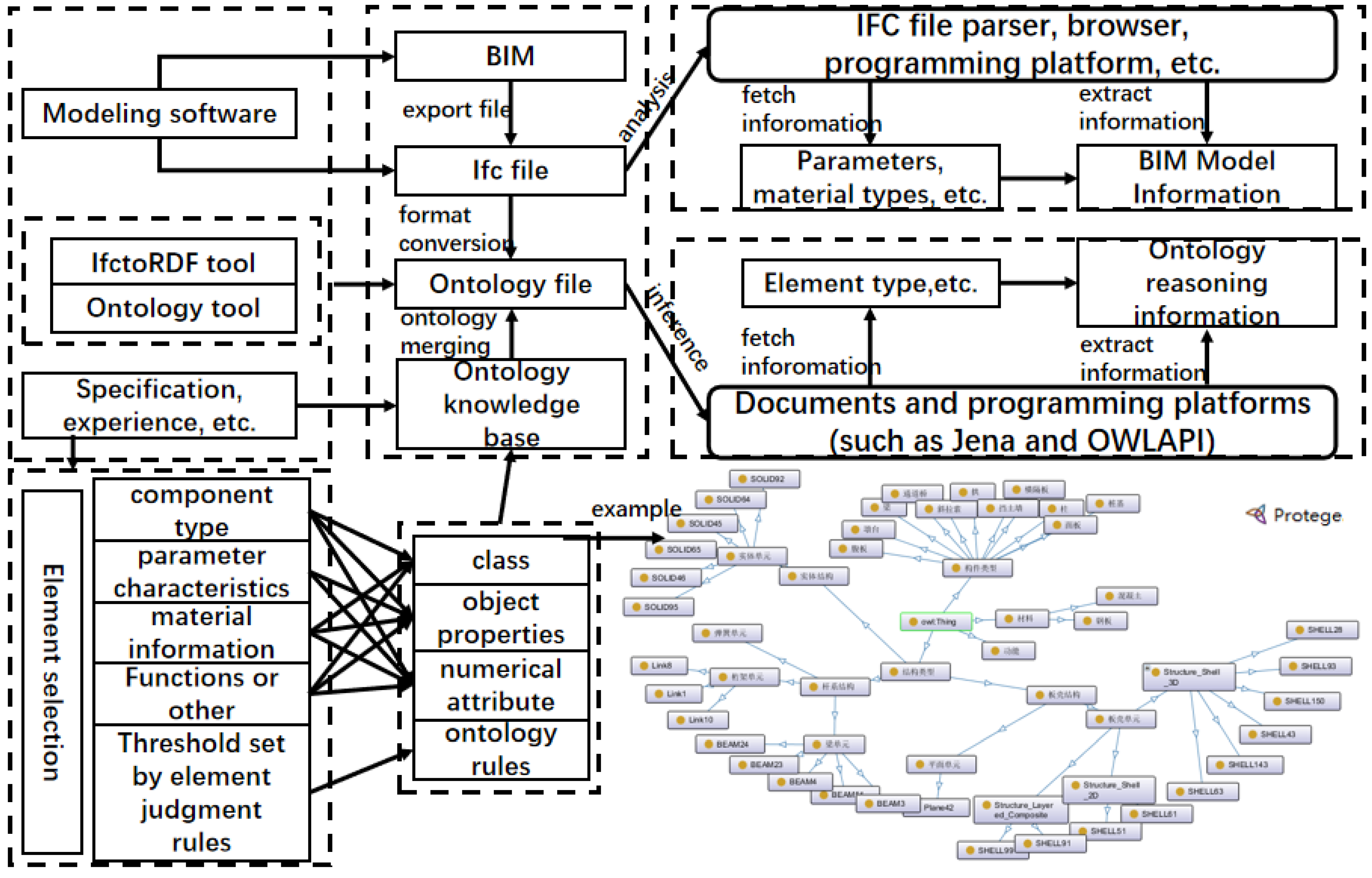

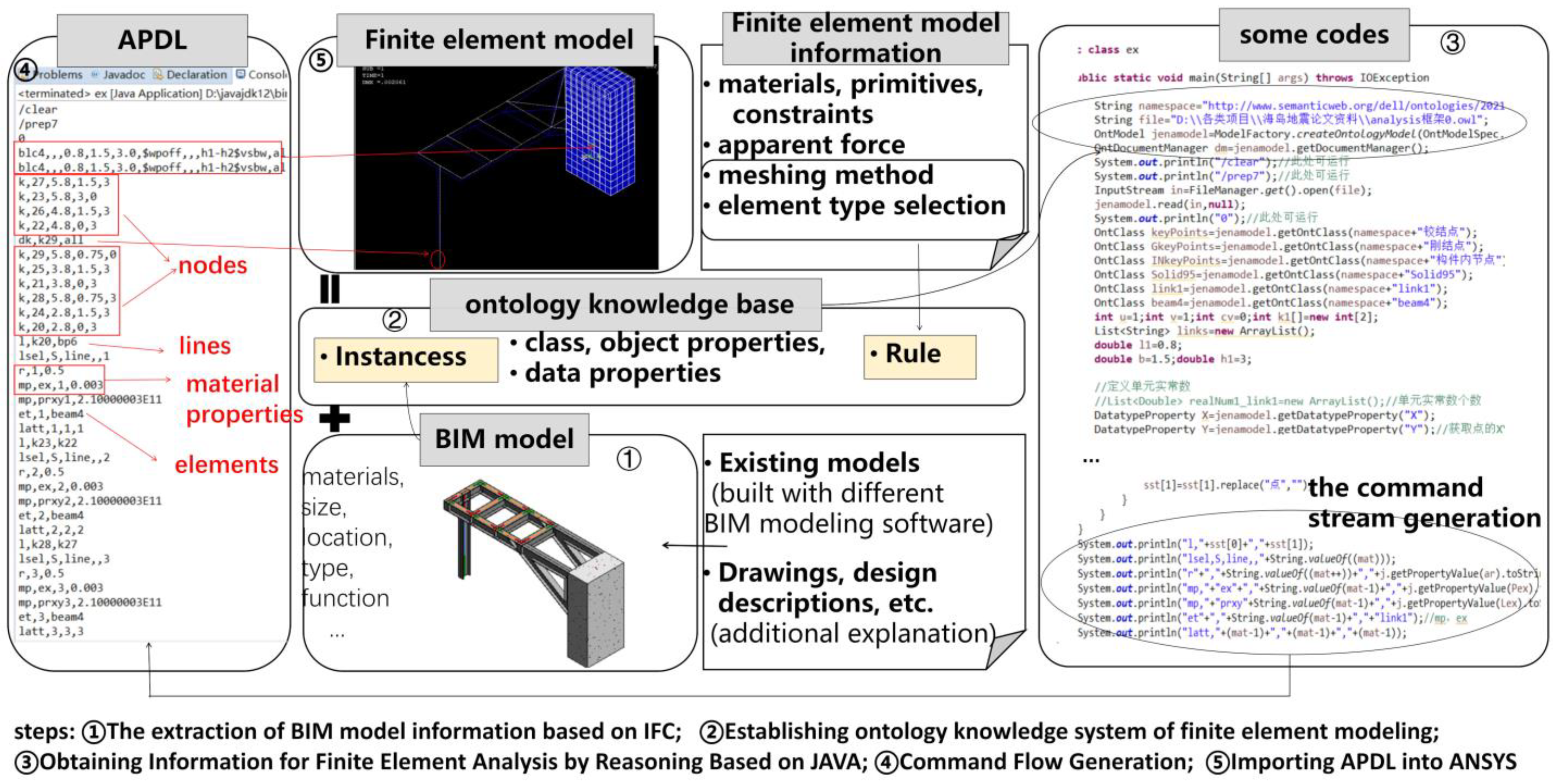

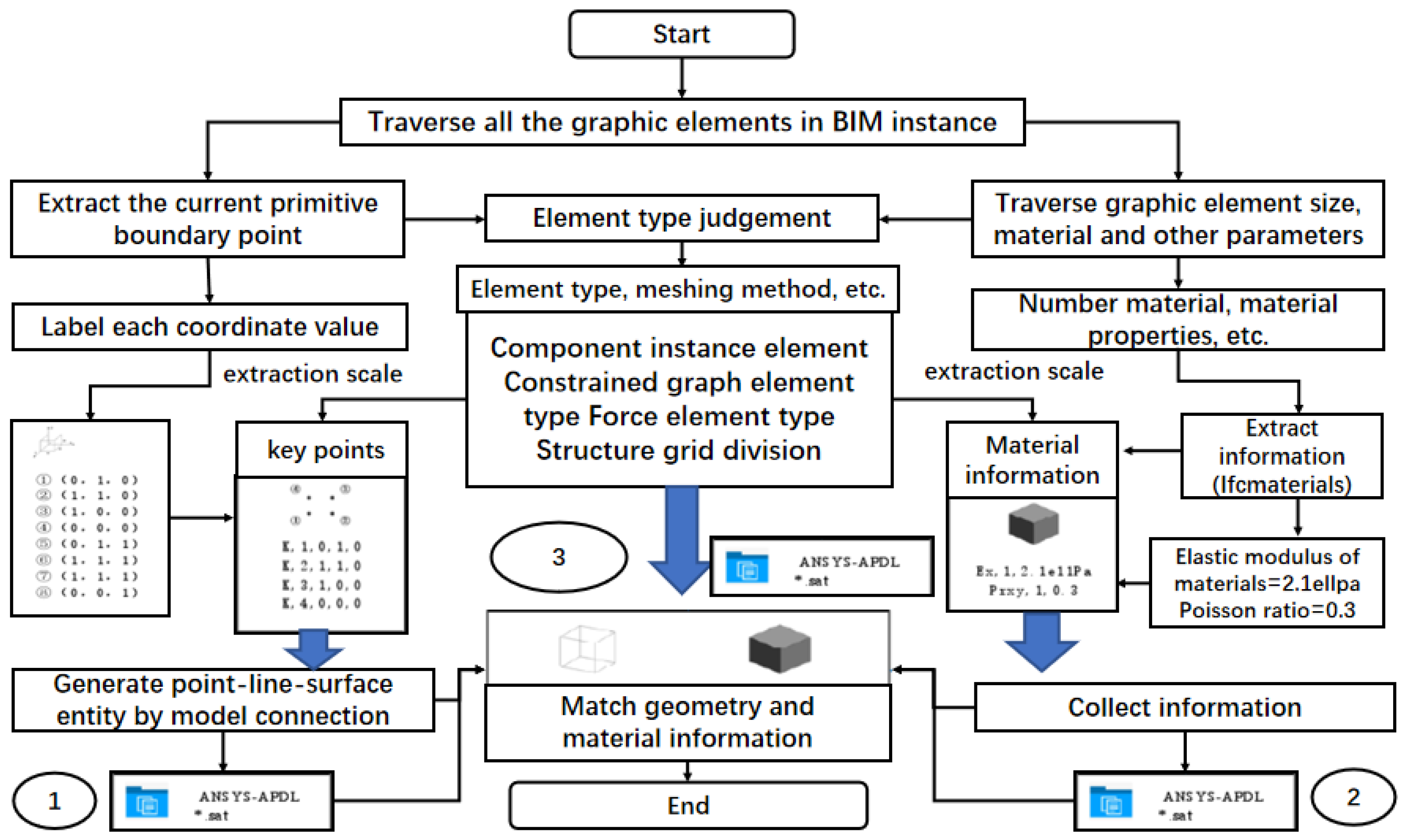
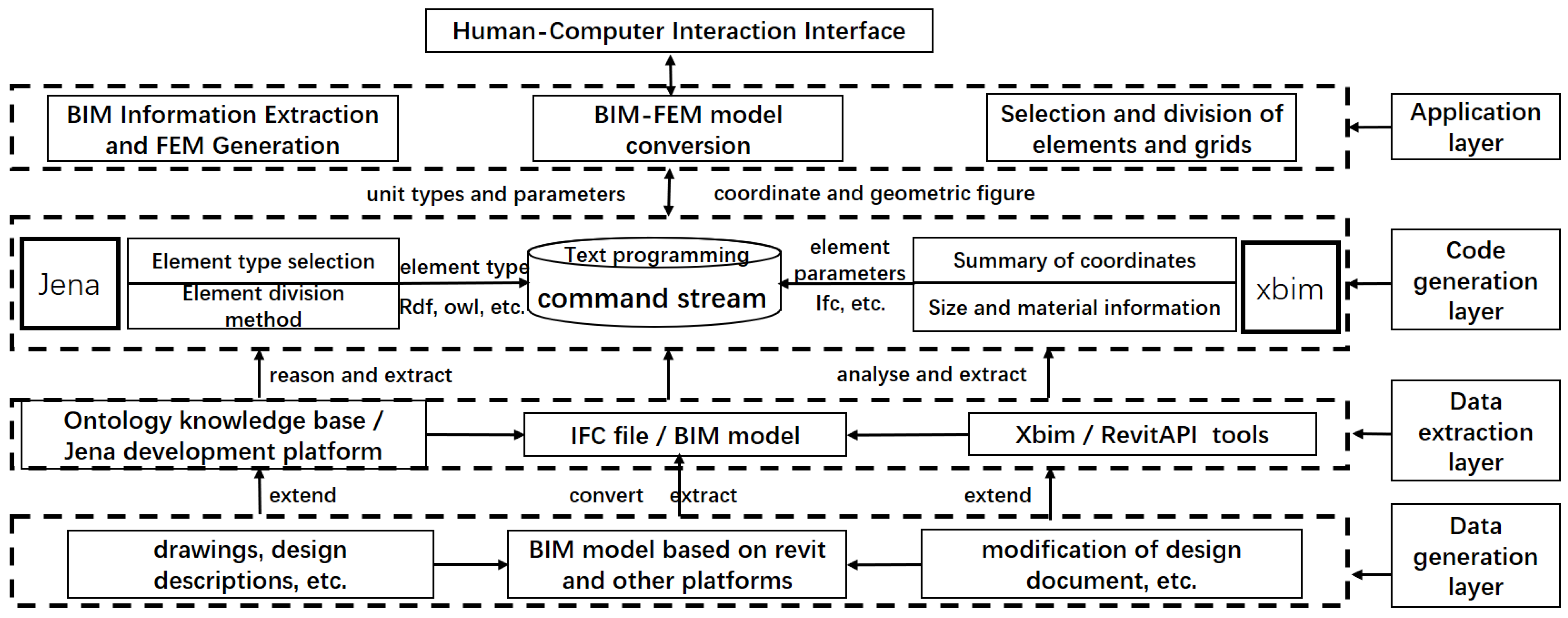
| Author | Platform | Mode | Content of Extension/Development | Object Model |
|---|---|---|---|---|
| Xiao [8] | Revit-PKPM | the R-star CAD software | extract the structural information with the Revit secondary development | high-rise shear wall |
| Zhou [9] | Rivet-ANSYS | Revit application programming interface | the geometry size, coordinates, material attributions, boundary conditions, and load information | two-floor structure |
| Habte [11] | Revit-ETABS/SAFE | an SBIM file type | develop Revit plugin to locate and read SBIM files | high-rise building |
| Zhao Xu [13] | / | IFC extension | extract and extend finite element structure information into the IFC standard mode | Simply supported girder bridge |
| Park [14] | Revit-Abaqus | IFC extension | extend new entities to support the meshfree analysis method | steel bridge |
| Zou [15] | / | octree generator + Polyhedron formulations | perform efficient mesh discretization | concrete frame structure |
| Alsahly [16] | / | IFC extension + ACIS format | extract the data regarding geology, alignment, lining, material, and process parameters | tunnel |
| Process | Sign | Main Content | Sample Diagram of Finite Element Command Flow |
|---|---|---|---|
| pre-processing | /prep7 | Creating geometric or finite element models, defining elements, defining material properties, defining element divisions, etc. | 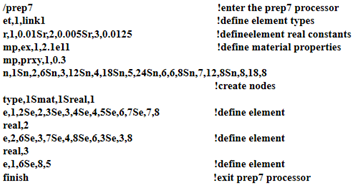 |
| general solving process | /solu | Applying loads and boundary conditions, defining solution types, defining solvers and solution methods, etc. |  |
| post-processing | /post1 | Viewing results, calculations, analysis, etc. |  |
| correspondence model | 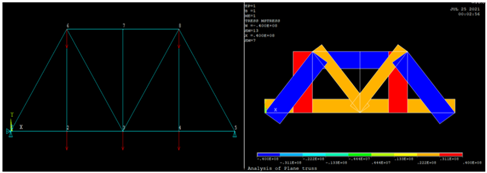 | ||
| Command Flow | Information |
|---|---|
| definition of element | The definition of element type corresponding to all components in BIM and the number of each element type |
| definition of materials | All material types, definition of main parameters, and number of material information in BIM |
| definition of primitives | Definition, numbering, and constructing process of point, line, surface, or other graphic elements |
| definition of parameters | Set cell types and material parameters defined for previous statements for each primitive model |
| definition of restriction | Set degree of freedom in all directions for important nodes in graph element model |
| definition of mesh | Grid division method and parameters representing grid precision, Quantity, and grid feature distribution law |
| force imposing | Types (such as concentrated load or uniform load), size, direction, and position of force |
| inputting of problem to be resolved | Results (deformation diagram, internal force diagram, bending moment diagram, node reaction force, etc.) |
| Finite Element Model Information | Method | Data Resource |
|---|---|---|
| materials, primitives, constraints | direct acquisition | BIM parameters |
| apparent force | design description or BIM | |
| meshing method | inference acquisition | reasoning rules based on information of element type, graph element, and material |
| element type selection | BIM parameters |
| Name | Structural Characteristic | Common Element Types |
|---|---|---|
| skeletal structures | The scale of one direction is much larger than that of the other two directions (beam). | Rod, beam, and tube elements |
| plate/shell structure | The scale of one direction is much smaller than that of the other two directions (plate/shell). | Shell element |
| solid structure | The scales in three directions are about the same magnitude (retaining walls, dams, and foundations). | 3D solid element, 2D solid element |
Publisher’s Note: MDPI stays neutral with regard to jurisdictional claims in published maps and institutional affiliations. |
© 2022 by the authors. Licensee MDPI, Basel, Switzerland. This article is an open access article distributed under the terms and conditions of the Creative Commons Attribution (CC BY) license (https://creativecommons.org/licenses/by/4.0/).
Share and Cite
Jia, J.; Gao, J.; Wang, W.; Ma, L.; Li, J.; Zhang, Z. An Automatic Generation Method of Finite Element Model Based on BIM and Ontology. Buildings 2022, 12, 1949. https://doi.org/10.3390/buildings12111949
Jia J, Gao J, Wang W, Ma L, Li J, Zhang Z. An Automatic Generation Method of Finite Element Model Based on BIM and Ontology. Buildings. 2022; 12(11):1949. https://doi.org/10.3390/buildings12111949
Chicago/Turabian StyleJia, Jing, Jieya Gao, Weixin Wang, Ling Ma, Junda Li, and Zijing Zhang. 2022. "An Automatic Generation Method of Finite Element Model Based on BIM and Ontology" Buildings 12, no. 11: 1949. https://doi.org/10.3390/buildings12111949
APA StyleJia, J., Gao, J., Wang, W., Ma, L., Li, J., & Zhang, Z. (2022). An Automatic Generation Method of Finite Element Model Based on BIM and Ontology. Buildings, 12(11), 1949. https://doi.org/10.3390/buildings12111949







